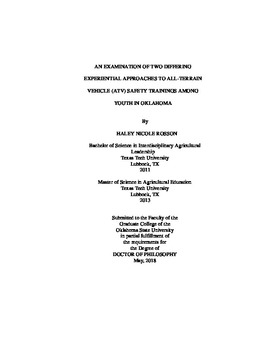| dc.contributor.advisor | Weeks, Williams G. | |
| dc.contributor.author | Rosson, Haley Nicole | |
| dc.date.accessioned | 2019-03-20T19:25:38Z | |
| dc.date.available | 2019-03-20T19:25:38Z | |
| dc.date.issued | 2018-05 | |
| dc.identifier.uri | https://hdl.handle.net/11244/317644 | |
| dc.description.abstract | Each year in the United States, hundreds of fatalities and thousands of accidents are reported related to all-terrain vehicle (ATV) usage. Youth are considered an especially at-risk population, predominantly children 16 years of age or younger, because they tend to ride without helmets or safety gear, carry passengers, ride on public roads and/or highways, and operate machines much too large and powerful for their size. This study examined two types of experiential approaches to ATV safety trainings: (a) an interactive training conducted at the Oklahoma Wildlife Expo, which included both a classroom segment and a riding segment, and (b) a school-based training, which included a presentation, coupled with static demonstrations using both youth- and adult-model ATVs and safety equipment, and a short film. Kolb's (1984, 2015) experiential learning theory served as the theoretical framework for this study. | |
| dc.description.abstract | A non-experimental, one-group survey research design was utilized to examine youth 10-18 years of age who participated in an interactive ATV safety training held at the 2017 Oklahoma Wildlife Expo. Prior to participation in the training, youth completed a self-reported questionnaire about their ATV usage behaviors and knowledge. Participants demonstrated mixed results pertaining to their level of ATV-related safety knowledge and behaviors, indicating that there is substantial room for improvement in terms of altering unsafe riding behaviors. | |
| dc.description.abstract | A one-group pre-test/post-test research design was utilized to examine youth participating in a school-based ATV safety training at a rural middle/high school in Oklahoma. Students completed a pre-test survey instrument designed to measure ATV usage behaviors and knowledge prior to participation in the training, and a post-test survey instrument approximately three months after the training was completed. Similar to the findings of participants from the Wildlife Expo, students in the school-based training demonstrated mixed results pertaining to their level of ATV-related safety knowledge and behaviors, indicating that the training was marginally effective at increasing ATV safety knowledge, and was largely ineffective at changing ATV-related behaviors. Continued research efforts are called for in order to improve existing training efforts. | |
| dc.format | application/pdf | |
| dc.language | en_US | |
| dc.rights | Copyright is held by the author who has granted the Oklahoma State University Library the non-exclusive right to share this material in its institutional repository. Contact Digital Library Services at lib-dls@okstate.edu or 405-744-9161 for the permission policy on the use, reproduction or distribution of this material. | |
| dc.title | Examination of two differing experiential approaches to all-terrain vehicle (ATV) safety trainings among youth in Oklahoma | |
| dc.contributor.committeeMember | Weeks, Penny Pennington | |
| dc.contributor.committeeMember | Baker, Marshall A. | |
| dc.contributor.committeeMember | Cole, Ki L. | |
| osu.filename | Rosson_okstate_0664D_15810.pdf | |
| osu.accesstype | Open Access | |
| dc.type.genre | Dissertation | |
| dc.type.material | Text | |
| thesis.degree.discipline | Agricultural Education | |
| thesis.degree.grantor | Oklahoma State University | |
